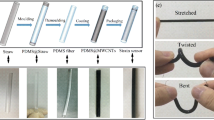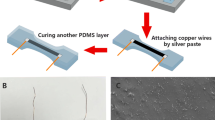Abstract
The piezoresistive effect, a phenomenon where electrical resistance changes in response to externally applied stress, is widely used in strain sensors. In this study, we focus on the development and characterization of flexible strain sensors using pressure-sensitive material composed of multi-walled carbon nanotubes and polydimethylsiloxane. The sensors are fabricated through an additive manufacturing process, allowing for versatile designs conforming to curved surfaces and enabling the measurement of large deformations. We investigate the response characteristics of these sensors under tensile deformation and analyze the influence of the number and width of wave peaks in the pressure-sensitive material on their electrical resistance changes. The results demonstrate that an increased number of wave peaks within the same area and larger tensile deformations lead to significant variations in electrical resistance, thus enhancing the sensor's sensitivity. Additionally, the recovery rate of initial electrical resistance upon deformation removal shows different trends depending on the number and width of wave peaks. These findings provide valuable insights into the design and performance of flexible strain sensors, paving the way for the further optimization and application of pressure-sensitive materials in diverse fields such as wearable devices, robotics, and healthcare devices.













Similar content being viewed by others
References
Hollander, L. E., Vick, G. L., & Diesel, T. J. (1960). The piezoresistive effect and its applications. Review of Scientific Instruments, 31(3), 323–327.
Tang, Z., Jia, S., Zhou, C., & Li, B. (2020). 3D printing of highly sensitive and large-measurement-range flexible pressure sensors with a positive piezoresistive effect. ACS Applied Materials and Interfaces, 12(25), 28669–28680.
Fekiri, C., Kim, C., Kim, H. C., Cho, J. H., & Lee, I. H. (2022). Multi-material additive fabrication of a carbon nanotube-based flexible tactile sensor. International Journal of Precision Engineering and Manufacturing, 23(4), 453–458.
Patel, S., Park, H., Bonato, P., Chan, L., & Rodgers, M. (2012). A review of wearable sensors and systems with application in rehabilitation. Journal of Neuroengineering and Rehabilitation, 9(1), 1–17.
Maheshwari, V., & Saraf, R. (2008). Tactile devices to sense touch on a par with a human finger. Angewandte Chemie International Edition, 47(41), 7808–7826.
Lee, G., Jeon, J., Han, S., Cho, J., Han, S.-W., & Lee, I. (2023). Development of epoxy-based flexible electrical conductor. International Journal of Precision Engineering and Manufacturing, 24(4), 1041–1052.
Yu, X.-G., Li, Y.-Q., Zhu, W.-B., Huang, P., Wang, T.-T., Hu, N., & Fu, S.-Y. (2017). A wearable strain sensor based on a carbonized nano-sponge/silicone composite for human motion detection. Nanoscale, 9(20), 6680–6685.
Egurrola, S. L., del Castillo Castro, T., Castillo Ortega, M. M., Encinas, J. C., Herrera Franco, P. J., Bonilla Cruz, J., & Lara Ceniceros, T. E. (2017). Electrical, mechanical, and piezoresistive properties of carbon nanotube–polyaniline hybrid filled polydimethylsiloxane composites. Journal of Applied Polymer Science, 134(18), 44780.
Fu, X., Ramos, M., Al-Jumaily, A. M., Meshkinzar, A., & Huang, X. (2019). Stretchable strain sensor facilely fabricated based on multi-wall carbon nanotube composites with excellent performance. Journal of Materials Science, 54, 2170–2180.
Fekiri, C., Kim, H. C., & Lee, I. H. (2020). 3D-printable carbon nanotubes-based composite for flexible piezoresistive sensors. Materials, 13(23), 5482.
Kim, S. H., Kim, H. C., & Lee, I. H. (2021). Study on the performance of flexible tactile sensors according to the substrate stiffness. Journal of the Korean Society of Manufacturing Process Engineers, 20(9), 104–109.
Lee, I. H., Choi, Y.-S., & Kim, H.-C. (2018). Additive fabrication of flexible tactile sensor using improved pressure sensitive material. Journal of the Korean Society for Precision Engineering, 35(9), 841–845.
Zhbanov, A. I., Pogorelov, E. G., & Chang, Y.-C. (2010). Van der Waals interaction between two crossed carbon nanotubes. ACS Nano, 4(10), 5937–5945.
Qin, Q., & Zhu, Y. (2011). Static friction between silicon nanowires and elastomeric substrates. ACS Nano, 5(9), 7404–7410.
Suhr, J., Koratkar, N., Keblinski, P., & Ajayan, P. (2005). Viscoelasticity in carbon nanotube composites. Nature Materials, 4(2), 134–137.
Acknowledgements
This work was supported by Basic Science Research Program through the National Research Foundation of Korea (NRF) funded by the Ministry of Education (No. 2021R1A4A1033141) and the National Research Foundation of Korea (NRF) Grant funded by the Korea Government (MSIT) (No. 2022R1A2C1091587).
Author information
Authors and Affiliations
Corresponding author
Additional information
Publisher's Note
Springer Nature remains neutral with regard to jurisdictional claims in published maps and institutional affiliations.
Rights and permissions
Springer Nature or its licensor (e.g. a society or other partner) holds exclusive rights to this article under a publishing agreement with the author(s) or other rightsholder(s); author self-archiving of the accepted manuscript version of this article is solely governed by the terms of such publishing agreement and applicable law.
About this article
Cite this article
Kim, S., Park, C.Y., Kim, C. et al. Design and Characterization of Flexible Strain Sensors Using Pressure-Sensitive Material with Multi-walled Carbon Nanotubes and Polydimethylsiloxane. Int. J. Precis. Eng. Manuf. 24, 2361–2369 (2023). https://doi.org/10.1007/s12541-023-00920-6
Received:
Revised:
Accepted:
Published:
Issue Date:
DOI: https://doi.org/10.1007/s12541-023-00920-6




